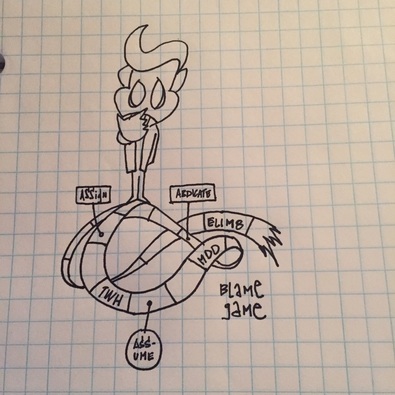 Who can fix this? Who? Who? Who can fix this? Who? Who? Going to do something a little different. The topic is accountability and we will present this topic in verses that relate to the chorus which will be provided by Magnified Plaid, or MxPx as they have come to be known. MxPx is a three piece indie punk rock band from Bremerton, Washington fronted by Mike Herrera and they have a fitting song entitled Responsibility, the chorus of which belts out, Responsibility? What's that? Responsibility? Not quite yet. Responsibility? What's that? I don't want to think about it; we'd be better off without it. Think of these sequence of articles as the verses and the song (video below) as the chorus as well as the rally cry was we discuss accountability. You may find the song catchy and inspiring, something that creates a soundtrack of momentum for you and your team. In preparation for the revised chorus of content we are about to unleash upon your reading eyes, mentally swap out "responsibility" for "accountability". Responsibility? What's that?
The song continues, "I don't want to think about it, we'd be better off without it." For many organizations, the attitude is the same with regards to a practical or effective approach to accountability. People in a position of leadership (PIAPOL) often talk about accountability as though the only measure of such is a good tongue lashing, preferably in front of as large a group of people as possible. So, let’s see if we can answer the what, when and how of establishing accountability. Accountability? What’s that? “If you are building a culture where honest expectations are communicated and peer accountability is the norm, then the group will address poor performance and attitudes,” says speaker and author of Necessary Endings, Dr. Henry Cloud. There is a progression in accountability, it does not appear out of thin air or materialize on its own. Accountability for a person and an organization comes from consistency in executing clearly established values. Effective accountability traces itself back to clarity in vision, communication of values and consistent effort from all levels within the team to live out those principles. As we have discussed many times, there are causes and there are effects or there are symptoms and there are sources, leaders are concerned with finding sources so that they can eliminate symptoms (more here). Accountability is the natural consequence of consistency rooted in clarity and conversely a lack of accountability is the natural consequence of inconsistency that stems from a void in institutional clarity. For an organization to build accountability they must clarify their vision and consistently communicate, train and discipline around their values. Accountability scenario: If an organization says they value A and B and yet they hire candidates that value C or have leaders who believe in D then that organization cannot expect A and B to be communicated clearly, executed consistently or accountability measures to be effective. As Dr. Cloud notes above, there is a beauty to developing a culture because one of the fruits of a clear culture is that those invested in the vision will enhance accountability by setting a standard and holding people to it. Accountability? What's that? Accountability is the progression or fruits of an organization that has defined it's vision and consistently executes it's values. Clarity leads to consistency which lays the foundation for accountability. Stay tuned for verse/segment 2...
1 Comment
 Loyalty. Quality. Quantity. Millennials. Loyalty. Quality. Quantity. Millennials. Are you a non-Millennial who has used some variation of the phrase, "Quality over quantity"? Are you a non-Millennial who has lamented about the good ol' days when employees were loyal? If you are in a position of leadership and you believe that quality is more valuable than quantity (or at least have said so publicly) and you struggle to find a connection with the new generations of workers arising in the marketplace, maybe we can help with some perspective. In an article published with YFS Magazine earlier this year, How Leaders Manage High Employee Turnover, we elaborated on some of these thought streams held by individuals who are in positions of leadership. Those in leadership who are frustrated with team development issues may find that if they engage their teams as they may find the answers are closer than they thought. As noted in the publication, how odd it is that those in leadership often seek the limited perspectives from those in their own peer group which results in only further widening the disconnect with younger generations rather than expanding their input base to include those who may assist with perspective expansion that coudl lead to real changes. Often the frustration between employer and employee centers around some aspect of loyalty, for example, “Employees just aren’t loyal like they used to be.” What is often missed is that organizations are not as loyal as they used to be either. The marketplace has changed which means companies and compensation packages have changed, therefore employment agreements have changed. Younger generations have seen what loyalty does to a long-term employee, i.e. their parents generation, who has been unceremoniously dumped by the company they gave life and limb to (sometimes literally) before their lucrative retirement package comes due. If you are a tenured employee who has risen in the ranks of an organization, you of all people should be able to identify with the lack of trust engendered by corporations where no one is safe. Millennials do not interpret these conditions as a mechanism for fear of investing themselves in an organization but they are savvy to market realities and will not be asked to produce a formal level of loyalty that doesn’t exist from the other end of the contract. We live in the era of “at will employment” which Millennials are in agreement with, it seems that organizations are the ones struggling with this fact. In their practical guide to “engaging Millennials in the insurance industry”, Tony Canas and Carly Burnham share insights that are applicable to all organizations through their recent publication titled Insuring Tomorrow. Addressing the topic of loyalty, the authors highlight a key perspective, “Millennials have a different definition of loyalty than previous generations did. For Boomers loyalty means, ‘I came, I stayed for 30 years, and I got my gold watch.’ For Millennials, loyalty means, “I worked very hard while I was there (p.27).” If we filter this statement back through our opening question about quality versus quantity, which generation applies that standard more accurately to their working definition of loyalty? If we can gain the perspective that for a Millennial worker, and for the current work environment, trust has a different meaning then we will understand that:
The next time you are tempted to score a Millennial lowly for their loyalty to the organization, ask first, is our team loyal to them (by a measure of quality over quantity) and secondly, is this individual giving their best effort while they are working with our team (also by a measure of quality over quantity). Tony and Carly offer further insights into engaging Millennials, “You need to understand that they’re comparable to a different culture, and as such, they communicate differently.” Those in a position of leadership understand that all individuals are unique, what works for engagement with one team member will not have the same results with the next one. The Millennial generation has some cultural distinctives, such as the aforementioned definition of loyalty, that create unique challenges in dealing with a group of employees. This is why managers are paid the moderately higher bucks – to learn to inspire, challenge and lead a team to achieve its vision by engaging their team members. Loyalty isn’t dead, it’s just been redefined. The changes in the work environment have been created as much by organizations as it has by the upcoming generations of workers, all parties need to work together to create success for their teams. The Millennial definition of loyalty will benefit all parties if applied from top to bottom and bottom to top as a qualifier.  How leaders respond to conflicts can either reinforce cultural values that strengthen the team or they can respond in ways that destroy morale. In organizational cultures everyone loves playing The Blame Game and bosses are particularly fond of the follow up game, Crap Rolls Downhill. Both are games are trademarked but neither has any clearly defined rules or pre-determined outcomes. The game is often initiated by conflict and the fantastical response of leadership to avoid responsibility for resolution. Play number one is to assign. This phase of the game is also so joyously referred to as The Witch Hunt. The dice are shaken, rolled and a conflict of sorts ensues as the numbers clamber upon the playing surface. Whether the inquisition is over employee issues, customer service, payments, product failures or the like, bosses will rally the wagons, feigning a quick and concerned response. As the dust settles on the parade of indignation the supervisory fingers are drawn from their holsters with an insatiable thirst for flesh. Assignment of blame is seen by many as a gold star in the managerial belt. If someone can be blamed then we can all conclude that The Witch Hunt was successful. All that a conflict needs in order to be resolved is for some party to be assigned the blame. Shake the dust from our hands and the sweat from our brows, our job is d-o-n-e. Play number two is to assume. When blame cannot be immediately assumed and The Witch Hunt cannot be satisfied, the participants of the game have to make a choice whether they will draw upon the Actually-Investigate-An-Issue card or select from the much thicker Deck of Assumptions. The scientific process is only for nerds, right? Why would any self-respecting manager, who’s time is worth more than pure San Francisco gold, dip their manicured fingers into the Mire of Dispute Discernment? Most management practitioners believe they have achieved their success by trusting their trustworthy gut, so why would conflict resolution be any different? The savvy boss already knows who is guilty, they don’t need crime scene analysis, jury review or the Supreme Court to tell them what they already assume is correct. Play number three is to abdicate. If the dice aren’t rolling correctly and assigning blame nor assumptions are advancing the player through business Candyland, the next option is to pull the wild card that enables a manager to abdicate responsibility. In these scenarios of unresolved conflicts a boss must draw upon prior experience to climb a ladder to boost themselves above the strife or quickly chute down and away from the controversy. If there is a report that says issues will resolve themselves then it must be right and it should be believed. The final alternative play that no one wants to talk about, like it’s some sort of cheat code that no one understands is to eliminate. Elimination of the conflict requires identification of the cause. Why are we in the negative situation that we find ourselves confronted with? What root sources do we need to address in order to ensure that we do not replicate the negative effects? Conflicts are continuous, they can happen at any moment for various reasons and they create an opportunity for growth within the organization. Unfortunately conflicts require leaders to get their hands dirty fixing people issues and process malfunctions but they also remind leaders to be hands on with people and processes. Elimination (Secret Code) Instructions: Crap hits the fan. Find the crap. Get the crap out of the system. Get the crap into a toilet. Flush the crap as soon as possible. Don’t pretend the crap doesn’t exist. Don’t smear the crap all around the office. Don’t kid yourself that the crap will take care of itself. There is an issue at work, people are upset. Everyone blames leadership and by leadership we mean you. Everyone is mad at you, again. Why is everyone so critical? Why does everyone always look at the leader when the messy stuff hits the fan and splatters all over the walls of the organization? Leaders (or "leaders") can respond a few ways to issues each with corresponding consequences: A) Face them; B) Ignore them; or 3) Disappear (hide) If the leader chooses Option A - face the issues - then there will be a process of gathering data (what happened), extracting truth from the data (or the attempt thereof) and making conclusions from the process (right or wrong). Whether management completes each step with flawless logic and execution or not, leaders that dare to engage (who are so brave as to do what they were hired for) will find that their teams respond to their efforts. There is a difference between ignorance and ignoring, this is the difference between the manager who was not aware that something was wrong and the manager who is aware but who's resolution strategy is in hoping that the office fairies will float the conflicts away so that they don't have to manage them. For most teams, there is as much frustration when a problem is brought to the attention of management and those leaders (with their extra zeros behind their annual salary) either ignore the issues or the boss disappears from the fray. In these scenarios, the team begins to conclude that leadership isn't necessary and management by their actions proves that their teams conclusions are functionally valid. For those in management that are tempted to employ the time tested tactics of Ignore and Hide (some may have proudly earned their degree in I&H), often the philosophy behind such actions revolve around the defeatist attitude of, "It can't be fixed anyways so why even try." Managers may be in a situation or a frame of mind where they feel that their team expects them to know everything and do everything correctly or perhaps the leader expects this of themselves. Leadership Key - Leadership is not about being omniscient. Leaders are not expected by their teams to know everything but they are expected to deal with issues when they are brought to light. A leader who places the burden of omniscience on themselves either views themselves far too highly or has been poorly mentored. Managers must understand that they are not god or Kuthulu, but as importantly a leader cannot be an ostrich (if you're slow that means don't bury your head in the sand). Leaders should not practice willful ignorance as this will frustrate your team far beyond whatever issue it was that they brought to management's attention. Like those books of our youth that had the multiple choice plot line pivots, when next the team brings a matter before the high council will our exciting lead character, The Manager (dun-dun-dun), choose to: A) Rise to the occasion and courageously perform the duties of their role by executing the aforementioned process of bringing resolution to the best of their ability. B) Take the ostrich approach and hope the issue passes by before the sand their head is buried in suffocates the life from their weak body. C) Exercise their one super power of disappearing whenever the heat rises in the organization's kitchen. While the writing quality of this piece is far superior to anything the reader has ever invested five minutes of their life on, it would be a shame to miss the point. To summarize what should be taken from the dried ink of these qwerty typed exclamations - if you are a leader you need to lead. One of the key tests of leadership merit and/or efficacy occurs when the team cares enough to bring an issue to management's attention, in that moment, a leader will demonstrate the need for their abilities or will prove otherwise. Key to leadership is understanding that leading is not about being omniscient but rather about being consistent. As a leader, the effort to address issues will prove much more positive long term to the health and engagement of the team than the absolutely detrimental effects of ignoring or hiding from challenges. Check in with our partners - MIZDOTBIZ for creative business solutions and [DYOJO] for managers helping managers manage. |
AuthorThoughts on personal and professional development. Jon Isaacson, The Intentional Restorer, is a contractor, author, and host of The DYOJO Podcast. The goal of The DYOJO is to help growth-minded restoration professionals shorten their DANG learning curve for personal and professional development. You can watch The DYOJO Podcast on YouTube on Thursdays or listen on your favorite podcast platform.
Archives
March 2023
Categories
All
<script type="text/javascript" src="//downloads.mailchimp.com/js/signup-forms/popup/unique-methods/embed.js" data-dojo-config="usePlainJson: true, isDebug: false"></script><script type="text/javascript">window.dojoRequire(["mojo/signup-forms/Loader"], function(L) { L.start({"baseUrl":"mc.us5.list-manage.com","uuid":"b9016446bd3c6a9f0bd835d4e","lid":"83282ffb9e","uniqueMethods":true}) })</script>
|
Jon Isaacson |
Connect. Collaborate. Conquer.
© COPYRIGHT 2015. ALL RIGHTS RESERVED.
|



 RSS Feed
RSS Feed